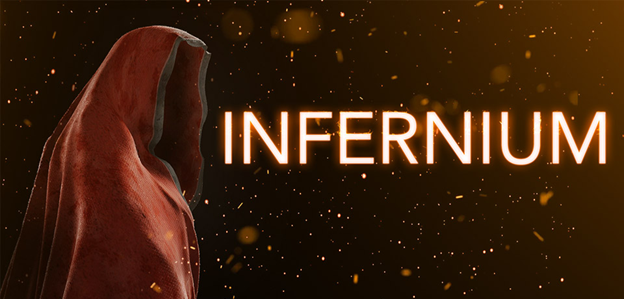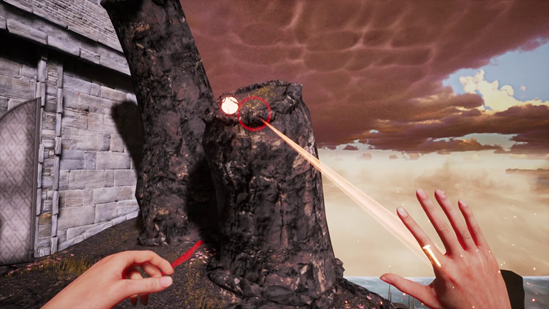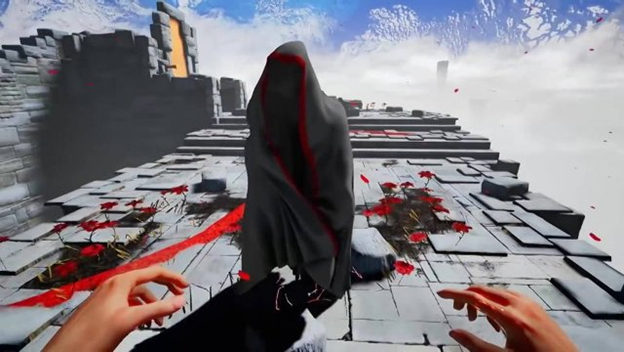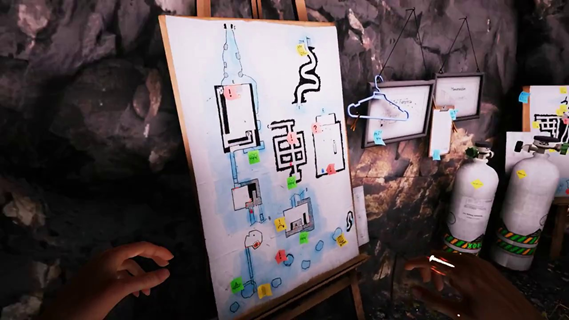INFERNIUM Review

In high school I read Dante’s INFERNO for the first time, and since then I’ve been interested in the idea of Hell not only as a place, but as a source or font of all the evil and truly profane forces that exist in the natural and unnatural world. Not only do you have Hitler permanently drowning in river of boiling blood, but you also have the dude whose job it is to watch over him and Attila the Hun and make sure they’re not getting too big of a breath every now and again. This generally macabre tableau permeates most facets of pop culture, from metal albums, to almost any given horror movie, to video games.

And yes, before you ask, I was incredibly disappointed
INFERNIUM is developer Carlos Coronado’s third game, positing a portrait of Hell not so much as a place of wailing and gnashing of teeth, but rather an endless trek through a vast, geometry-defying landscape, all while being pursued by its silent guardians. Players are dumped into the world of Infernium abruptly, with only the abilities to harvest orbs of light and teleport to a limited extent on your side. There’s no immediate goal in INFERNIUM; eventually “go forward” becomes “find an exit,” and there’s not immediately much of a narrative to guide you.
You can kind of feel the influences that went into INFERNIUM; there’s a little bit of MYST and a little bit of THE WITNESS to it, as again, there’s no real narrative or guiding force to the game. The way forward is often blocked by ghostly figures that endlessly pursue the player in a way that has been compared not-so-inaccurately to PAC-MAN. These puzzles are often set in labyrinthine chambers that can easily discombobulate the player, getting them completely turned around in a suddenly unfamiliar hallway. This is mostly what happens in INFERNIUM, and the only clear signs that you’ve progressed at all are when you uncover new areas and new powers. You’ll be sidestepping ghosts and teleporting through hallways when all of sudden your character—represented only by a pair of hands—will gain another tattoo or have a new symbol carved into them. It’s then up to you to figure out what and where the applications of these abilities are, and how they can be used to move forward. The game encourages this experimentation, as most of the time just screwing around unlocks entire areas that were previously unnoticed.

Really, who gets to decide what “line of sight” means anyway?
One puzzle I wasn’t a fan of was what INFERNIUM chooses to tell the player and what it expects them to discover on their own. For instance, I spent most of the game thinking that the teleportation function was powered by light, which would explain why there are so many lumen-providing orbs for the player to collect. However, the point came where I ran out of light and found I could still teleport. I later found that there are certain structures that you can deposit your light into, and I assumed filling the gauge would give me a new ability, but every time I died I’d find that the gauge would be reset.
It wasn’t until much, much later that I discovered that every time I emptied a storage of light into the structure I replenished a life that I’d lost by falling off a cliff or getting bodied by one of the robed ghosts. This was important to know, because the game uses a permadeath function and after all of your lives are exhausted you’re forced to start over from the very beginning. I’d learned earlier that stored light was also used to open certain doors, but this was a much more immediately apparent function than prolonging my game, an aspect I would have prioritized from the start had I known it was even possible.

Don’t kill me! There are so many corridors I’ve yet to traverse!
Coronado walks a pretty thin line between showing and telling, and sometimes he comes up short. The central theme of the game seems to be discovery, and learning how the powers and rules and work seems to be a major part of that theme. Similarly, there IS narrative to INFERNIUM, but unobservant players may miss it entirely. There are moments where Coronado’s sense of game design is impeccable, as gameplay elements are introduced and explained through gameplay, then grow more complicated and hectic as the player progresses through the level. Then there are moments where the way something is supposed to work is entirely imperceptible, and there are a few places where I advanced through the level by exploiting a glitch in the game’s physics.
That said, I enjoyed my time in Hell. INFERNIUM makes use of noises like the crackling of a fire, dew dripping from stalactites, and distant, distorted choirs to create a soothing soundscape. The result is lulling the player into a sense of security, only to shatter that facade with the violent stings and frenzied violins signalling that they’ve drawn the attention of a sentinel of Hell. Some may see this as a cheap use of shock in order to “get” players, but as someone who is both wary and weary of jump scares in games, INFERNIUM’s kept me permanently glued to the edge of my seat. In addition, the vistas are something special, making full use of the Unreal 4 engine to generate some truly bizarre Hellscapes. The world is at once vast and cramped, sprawling and confined, a true enigma of nightmare logic and dreamlike visuals.

If you take a left at the Cavern of the Abyss and head straight to the Waterfall That Has No Source . . .
I found myself wanting to come back to INFERNIUM every time I put the controller down, eager to discover what the next section of the world had to offer. I felt like I could master even the most difficult trials if I just worked at them long enough, and I was always intrigued enough to see things through to the end. There’s almost something inherently fun and rewarding when a puzzle is solved, and that, along with its sense of mystery, is the heart of INFERNIUM, where the ever-present threat of total failure competes with one’s desire to explore and grow more powerful. While there are no doubt rough edges and imperfections, INFERNIUM presents an engaging portrait of a Hell that doesn’t imprison captives through divine wrath but through their own nagging sense of curiosity.
Verdict: Recommend
Reviewed on PlayStation 4




1 Response
[…] second Hell simulator of 2018, I can’t say in good faith that AGONY doesn’t do a better job of representing the tableau than […]